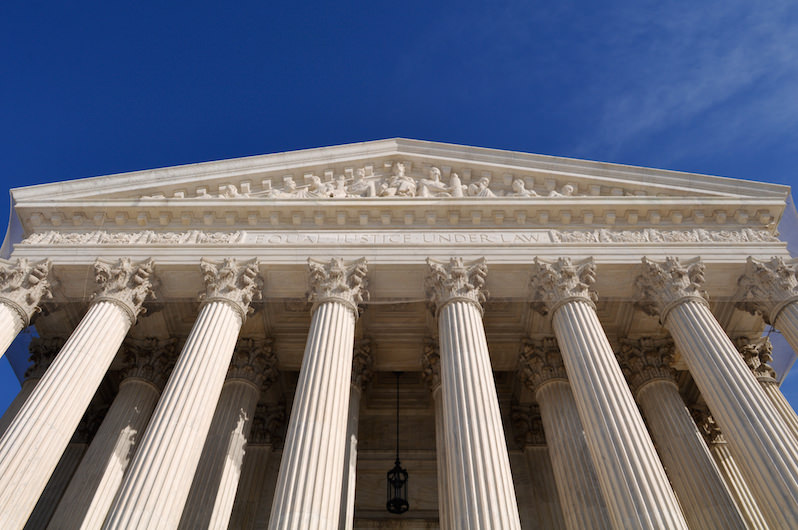Is a Libertarian-Conservative Fusion Driving the Roberts Court?
Whatever the explanation for the Supreme Court’s direction, it’s bad news for the little guy. Shutterstock
Shutterstock
You know that a jurisprudential sea change is underway at the Supreme Court when a venerable mainstay of American liberalism like New York Times columnist Linda Greenhouse has lost faith in the nation’s highest judicial body. Yet that is exactly what Greenhouse has confessed in two recent Op-Eds dealing with the latest challenge to Obamacare: King v. Burwell, the case contesting the validity of federally run insurance exchanges that is set for oral argument March 4.
In the first of her two pieces, published in November, Greenhouse described the court’s decision to hear Burwell as “a naked power grab by conservative justices who two years ago just missed killing the Affordable Care Act in its cradle” in the opinion that upheld the act’s individual mandate under Congress’ taxation powers. “In decades of court-watching,” Greenhouse wrote, “I have struggled — sometimes it has seemed against all odds — to maintain the belief that the Supreme Court really is a court and not just a collection of politicians in robes. This past week, I’ve found myself struggling against the impulse to say two words: I surrender.
Greenhouse reiterated those fears in her second piece, published last week. There, she declared that the “honor of the Supreme Court” hangs in the balance, depending on how it resolves the Burwell litigation.
While Greenhouse and other top mainstream legal observers, such as her Times colleague Adam Liptak, excel at describing the polarization on the high court, they usually come up short at explaining its causes. The most critical question isn’t whether the court under the leadership of Chief Justice John Roberts has taken a sharp political turn to the right, but why it has done so and where, ideologically, it is taking us. Is something else going on big-picture-wise besides the transparently obvious cleavage of the tribunal’s nine justices along party lines?
One attempt at explication worthy of consideration has come from Damon Root, a senior editor at Reason magazine. In his book “Overruled: The Long War for Control of the U.S. Supreme Court,” released in November and only now attracting the widespread attention it deserves, Root argues that we are witnessing a historic transformation at the court, pitting libertarianism as a judicial philosophy against conservatism, with the former emerging as the ultimate victor.
Both camps, according to Root, decry federal intervention in society, the environment and the marketplace. But to achieve their ends, he writes, libertarians favor judicial activism while conservatives caution restraint.
In truth, of course, none of the justices on the current court fall entirely into one category or the other. At times, for example, Antonin Scalia has assumed the libertarian mantle, as he did dissenting in the 2013 case of Maryland v. King, arguing that the majority’s approval of routine post-arrest cheek swabs to obtain DNA identifiers hearkened back to the general warrants that the Fourth Amendment was ratified to prohibit. On the issue of gay marriage, by contrast, the homophobic Scalia is the epitome of conservative restraint, advocating that the court defer to state legislatures that have opted to confine marriage to traditional heterosexual unions.
Even Clarence Thomas, whom Root portrays as the most consistently libertarian voice on the court, has oscillated between the two attitudes. While Thomas voted with the court majority—not with Scalia—in Maryland v. King and is widely believed to be a conservative on gay marriage, he adopted the most extreme libertarian posture in McCutcheon v. FEC, last term’s landmark ruling that overturned the aggregate limits that individuals can donate directly to candidates in federal elections, arguing in a separate concurrence that all campaign contribution limits should be stricken.
Still, Root’s analysis is helpful in clarifying how an institution as right-wing as the Roberts court can, on the one hand, gut the Voting Rights Act, uphold the religious-based freedom of closely held corporations to deny their employees health insurance for birth control and, on the other hand, unanimously rule as it did last year that absent exigent circumstances, police searches of cellphones without a warrant are unconstitutional. The libertarian impulse may also prompt the court (albeit with a different majority of justices dominated by its Democrats) to recognize a constitutional right to same-sex marriage later this term.
Whether the libertarian-conservative dynamic actually constitutes a war or even a pervasive conflict, as Root believes, is another matter. As the fluctuating views of Scalia and Thomas illustrate, the libertarian and conservative mindsets of the current crop of Republican justices generally have combined and fused in complementary fashion to move the Roberts court in the direction it has taken.
Thomas and Scalia, as well as Roberts and Justice Samuel Alito, also have been linked as past or present members of the Federalist Society, the influential think tank that facilitates exchanges of ideas among lawyers, judges, activists and academics who espouse both libertarian and conservative legal outlooks. The Society’s conferences, practice groups and publications amply demonstrate that the two outlooks more often go hand in hand rather than clash.
But the most important gap in Root’s narrative isn’t whether he has missed or understated the essential fusion of modern-day libertarianism and old-line conservatism on the Supreme Court, but rather a question he never seriously examines: whether that fusion has benefitted average Americans.Historically speaking, today’s libertarianism represents the revival of a belief system that dominated the high court and American politics from the 19th century until it seemingly met its demise with the coming of the New Deal. At the heart of that system, as Chicago-based attorney Michael O’Donnell has written in a recent review of Root’s book in the Washington Monthly, is the concept of “liberty of contract.”
Guided by this doctrine, before the great turnaround of the 1930s, the Supreme Court invalidated a host of progressive state and federal laws, including those aimed at limiting maximum weekly work hours (Lochner v. New York) and prohibiting the employment of children under 14 in factories (Hammer v. Dagenhart). As the court held in Lochner, a controversy involving New York bakeries, “The … right to make a contract in relation to … business is part of the liberty protected by the [due process clause of the] Fourteenth Amendment, and this includes the right to purchase and sell labor.”
This was not simply a conservative or libertarian sentiment, but a reactionary one that left the vast majority of workers exploited and unprotected. Unfortunately, it is also a sentiment that has resurfaced on the Roberts court.
Just as for the bakery workers who were the subject of Lochner and the children who were at issue in Hammer, most of us today have been and are likely to remain disadvantaged—dare I say, “screwed”—by the present court’s overall handiwork. As in the days of Lochner and Hammer, the biggest beneficiaries of the current court have been and are likely to remain business and corporate interests that have little regard for the common good.
This is the big picture that most fully informs and explains the partisan divide that Linda Greenhouse laments in her latest columns on Obamacare. It’s one worth keeping in sharp focus.
Your support matters…Independent journalism is under threat and overshadowed by heavily funded mainstream media.
You can help level the playing field. Become a member.
Your tax-deductible contribution keeps us digging beneath the headlines to give you thought-provoking, investigative reporting and analysis that unearths what's really happening- without compromise.
Give today to support our courageous, independent journalists.









You need to be a supporter to comment.
There are currently no responses to this article.
Be the first to respond.